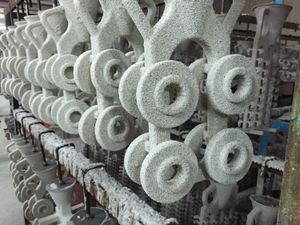For as frequently as I use the word in conversation, I really don’t chop things that often. Rarely in the kitchen: I mostly slice, carve, mince. Almost never to a living plant: I trim, prune, and pick frequently, and nearly all of my felling has been with a chainsaw, which really only qualifies to be used with the more generic term, cut. I cannot think of a single instance in which I have chopped at something metallic, though I have drilled, milled, tapped, and filed both ferrous and nonferrous metals. I’ve probably employed the greatest range of cutting verbs to lumber, but even there, true chopping is if anything even more rare. I’ve often sliced up a full sheet of plywood with a track saw; I’ve chiseled and carved and mortised woods hard and soft; I enjoy shaving faces along the grain, and trimming faces against it, and easing the areas where the two meet. I’ve whittled and split and applied a profile. But rarely do I strike something with a quick blow from a piece of sharpened steel; rarely do I chop.
I bring this up because I sold my chop saw recently. A standard issue Hitachi C10FSH, I had purchased it on Long Island late in 2008, as a replacement to an identical saw that I had declined to transport across the country a few months earlier. Hitachi — which isn’t really Hitachi anymore, as the conglomerate sold their power tools company to a private equity firm in 2017 — calls the C10FSH a “sliding compound miter saw,” for the fact that a) the cutting head slides in and out to accommodate a wide variety of board widths, and b) the head can be tilted along two different axes to make “compound” cuts. But on a jobsite it’s usually called a chop saw, and in my experience it’s one of the most frequently used tools on site.
Why are chop saws so heavily used? Partly for their adjustability, no doubt: In the circumstances in which a compound angle needs to be cut, a compound miter saw is a superlative option. But if you find a chop saw in the wild, it’s more likely than not to be set up for square cuts, its adjustable handles all snapped into their zero positions. Like this, the chop saw’s primary attribute is repeatability and precision — traits which are almost antithetical to its namesake.
Anyway: I have been with a chop saw for about twenty years. And now I am without one.
What does a life without a chop saw feel like? I pull my length with a tape measure as normal, marking it in pencil with a sharp "V". I take my square, line it up to the "V", and mark the cut on two faces (the back and the front). I put the square down, tuck the pencil behind my ear, and pick up a 12" pull saw. I rest my left hand on the board, the tip of my thumb hovering above my line, and hold the pull saw just above the top front corner, against my thumb. I take a pull, just grazing the corner; I lift slightly and push, lower slightly and pull, and now I'm in a rhythm, have found/am making a groove, start making little adjustments to correct for placement and angle of attack. I keep moving — cutting down the front face a little bit, then up the top face, working each direction off the other to keep the cut planar and square in both orientations. It's only a couple dozen strokes before my lines are gone, the cut plane is established, and now I'm taking it easy, following the path I've already established, pull — pull — pull, and when I get down to the rear back corner I remember that I'm cutting over thin air. If the offcut is big, I might tip the board up on its back; either way I take the last strokes decisively, timing the moment at which the final fiber fails. I determine this moment by sound, listening to the way the whole assembly vibrates, noticing how its tone becomes clear and sonorous as the offcut begins to waver.
When the last stroke comes — I'm guessing at this, but it's a reasonably good guess — I crouch down just a little bit more, coil up, and take one final pull. The blade of my saw, recently replaced and very sharp, flies through the board with little resistance, and the offcut drops to the ground, ringing out as it strikes the concrete and dispersing a little puff of sawdust as it comes to rest.
SCOPE CREEP.
- Just putting it here for posterity: I will not buy a Lie-Nielsen shooting plane!

- I have, for almost three years now, had the above gif in a folder of often-referenced files on my computer. It shows workers cutting down a very large Japanese cypress tree using the "three-string" method, and every few months I've looked at the filename and thought that I should write about it. I recognize that this may never happen; on the other hand, here I am writing about it, and though this is mostly just a note to acknowledge my own state of mind, perhaps there is more to come.
- Here's a random, 35-minute video of corn silage being chopped at a dairy farm in Indiana. According to the National Corn Handbook (a project of Purdue's co-op extension), "the goal in making corn silage is to efficiently harvest and store the maximum amount of digestible nutrients [for dairy cattle] per unit of land area." To achieve this, the entire corn stalk is cut, chopped, and shot into the bed of a truck at high speed; new trucks are swapped in seamlessly in order to save time. Interestingly, corn silage is a fermented food: naturally occurring bacteria on the plants digest the plant's carbohydrates, producing acetic and lactic acid and preserving the food energy for later use.
Thanks as always to Scope of Work’s Members and Supporters for making this newsletter possible.
Love, Spencer.




